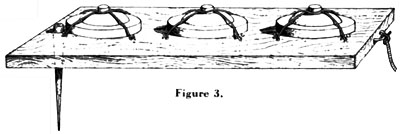VULNERABILITY OF THE PZ. KPFW. VI
A tank is such a complicated weapon, with its many movable parts and its elaborate mechanism, that it is particularly valuable to know its points of greatest vulnerability. Recently the Soviet Artillery Journal published a number of practical suggestions, based on extensive combat experience, regarding the vulnerability of the Tiger.
All weapons now used for destroying German tanks  antitank guns and rifles, caliber .50 heavy machine guns, antitank grenades, and Molotov cocktails  are effective against the Pz. Kpfw. VI.
1. Suspension System.  The mobility of tanks depends upon the proper functioning of the suspension parts: the sprocket (small driving wheel), the idler (small wheel in the rear), the wheels, and the tracks. All these parts are vulnerable to shells of all calibers. The sprocket is especially vulnerable.
Fire armor-piercing shells and high-explosive shells at the sprocket, idler, and tracks.
Fire at the wheels with high-explosive shells. Use antitank grenades, antitank mines, and movable antitank mines against the suspension parts. Attach three or four mines to a board. Place the board wherever tanks are expected to pass. Camouflage the board and yourself. As a tank passes by, pull the board in the proper direction and place it under the track of the tank.
[A German source states that this method was successfully used on roads and road crossings in Russia, and that it still is taught in tank combat courses for infantry. The mine is called the Scharniermine (pivot mine). It consists of a stout length of board, 8 inches wide by 2 inches thick, and cut to a length dependent on the width of the road to be blocked. A hole is bored at one end, through which a spike or bayonet can be driven into the ground, thus providing a pivot for the board. A hook is fastened to the other end of the board, and a rope is tied to the hook, as shown in Figure 3. Tellermines are secured to the top of the board.
One man can operate this mine. After the board has been fastened down at one end with the spike (in emergencies, a bayonet) and a rope tied to the hook at the other end, the board is laid along the side of the road. On the opposite side of the road, a man is posted in a narrow slit trench. He holds the other end of the rope. When a tank approaches, the tank hunter waits until it is close enough to the pivoted board, and, at the very last moment, he pulls the free end of the board across the road. The rope and slit trench must be well camouflaged. A good deal of emphasis is placed on this point.]
2. Side Armor Plates.  There are two armor plates on each side of the tank. The lower plate is partly covered by the wheels. This plate protects the engine and the gasoline tanks, which are located in the rear of the hull  directly beyond and over the two rear wheels. Ammunition is kept in special compartments along the sides of the tank. These compartments are protected by the upper armor plate.
Fire armor-piercing shells from 76-, 57-, and 45-mm guns at the upper and lower armor plate. When the gas tanks or ammunition compartments are hit, the vehicle will be set on fire.
3. Rear Armor Plate.  The rear armor plate protects the engine, the gasoline tank, and the radiators.
Use antitank guns. Aim at the rear armor plate. When the engine or the gasoline tanks are hit, the tank will halt and will begin to burn.
4. Peepholes, Vision Ports, and Slits.  The main turret has two openings for firing small-arms weapons, and two vision ports. The turret has five observation slits. There are two sighting devices on the roof of the front part of the tank  one for the driver, the other for the gunner. There is also a port with sliding covers in the front armor plate.
Use all available weapons for firing at the peepholes, observation ports, vision slits, and the ports for small-arms weapons.
5. Turrets.  The commander's turret is an important and vulnerable target.
Fire high-explosive and armor-piercing shells of all calibers at the commander's turret. Throw antitank grenades and incendiary bottles after the turret has been damaged.
The tank commander, the turret commander, and the gunner ride in the turret. The tank gun and many mechanical devices are found in the turret.
Fire at the turret with 76-, 57-, and 45-mm shells at ranges of 500 yards or less.
6. Tank Armament.  The turret is armed with a gun and a machine gun mounted coaxially. Another machine gun is found in the front part of the hull. It protrudes through the front armor plate, on a ball mount, and is manned by, the radio operator.
Concentrate the fire of all weapons on the armament of the tank. Fire with antitank rifles at the ball mount of the hull machine gun.
7. Air Vents and Ventilators.  The air vents and the ventilators are found under the slit-shaped perforations of the roof of the hull, directly behind the turret. Another air vent is located in the front part of the roof, between the two observation ports used by the radio operator and the driver.
Use incendiary bottles and antitank grenades to damage the ventilating system.
8. Tank Floor.  When an antitank mine explodes under the tank, the floor of the tank is smashed, and the tank is knocked out of action.
9. Base of Turret.  There is a 10-mm slit going all around the turret, between the base of the turret and the roof of the hull.
Fire at the base of the turret with heavy machine guns and antitank guns, to destroy the turret mechanism, and disrupt the field of fire. Fire with high-explosive shells at the base of the turret in order to wreck the roof of the hull and put the tank out of action.

